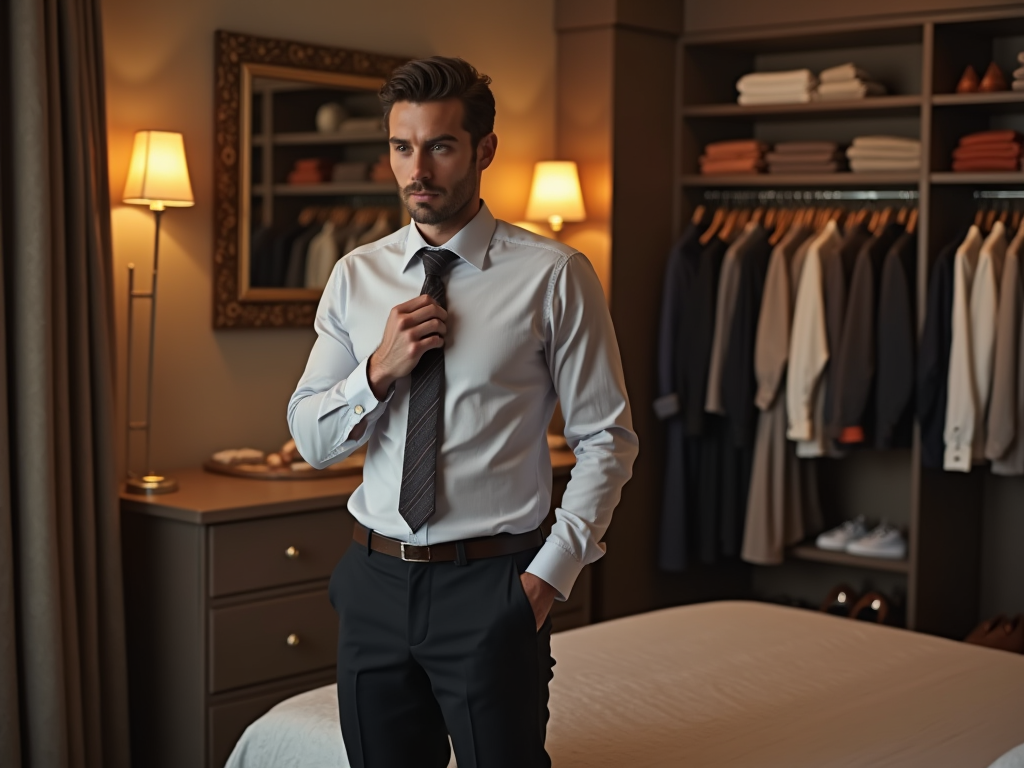In today’s business environment, the dress code has evolved significantly, allowing men to express their individuality while still maintaining an air of professionalism. This evolution has given rise to the concept of business casual, a style that blends comfort with sophistication. Understanding how to navigate this dress code can make a substantial difference in how you present yourself in the workplace. The right balance can bolster your confidence, enhance your professional image, and even positively affect your career progression. Here, we’ll dive into the essentials of business casual style, shedding light on the key pieces that every man should consider including in his wardrobe. From essential attire to grooming tips, our guide is tailored to elevate your everyday look.
Understanding Business Casual: What It Means

Business casual is more than just a vague guideline; it is a thoughtful summation of smart, stylish, yet relaxed attire suitable for various workplaces. Unlike the rigid formality of traditional business wear, business casual allows for flexibility and personal expression. However, it is crucial to acknowledge that “business casual” can vary greatly from one office environment to another. Some workplaces might have a more laid-back interpretation of the style, while others might lean towards a more formal approach. To navigate this successfully, one must be keenly aware of their workplace culture and the expectations therein. Ultimately, business casual is about looking polished without needing a tailored suit or tie, offering a harmonious blend of professionalism and comfort.
- Smart yet Comfortable: A business casual ensemble should be both comfortable and professional, allowing you to work effectively throughout the day.
- Versatile: This dress code accommodates various situations, whether it’s an important meeting or a casual team lunch.
- Accessory Friendly: Thoughtful accessories can enhance your overall look, adding a touch of your personal style to the outfit.
Essential Pieces for a Business Casual Wardrobe

Building a business casual wardrobe doesn’t require a complete overhaul. Instead, focus on selecting versatile pieces that can be mixed and matched easily. Here are some fundamental items you should consider including in your collection:
Tops: The Foundation of Your Outfit
- Dress Shirts: Opt for solid colors or subtle patterns that maintain a polished look.
- Polo Shirts: A more relaxed option while remaining tidy, perfect for casual settings.
- Sweaters: Lightweight pullovers or cardigans can add warmth and sophistication to your overall appearance.
Bottoms: The Right Fit
Choosing the right bottoms is equally important in achieving a well-rounded business casual look. You should aim for a fit that is comfortable while projecting professionalism. Here are some excellent options:
| Type | Description |
|---|---|
| Chinos | A smart alternative to jeans, offering both comfort and a professional appearance. |
| Dress Pants | Tailored trousers in neutral colors that work well for meetings or office work. |
| Dark Jeans | In some workplaces, they may be acceptable as part of a business casual outfit if styled properly. |
Footwear: Stepping Up Style
No outfit is complete without the right pair of shoes. Footwear plays a crucial role in solidifying your business casual approach. Here’s a list of ideal shoe styles to consider:
- Loafers: Offering both comfort and class, loafers can be paired seamlessly with a range of outfits.
- Brogues or Oxfords: These are perfect for more formal occasions, such as client meetings or presentations.
- Clean Sneakers: In some contemporary office settings, minimalist sneakers can be an excellent choice, adding a relaxed vibe while looking polished.
Accessories to Enhance Your Look
Accessories play a pivotal role in defining business casual attire, allowing you to personalize your look further. Incorporating the right accessories can significantly enhance your overall appearance. Essential accessories to consider include:
- Belts: A good leather belt that matches your shoes can bring the whole outfit together.
- Watches: A classic timepiece adds a sophisticated touch to any business casual ensemble.
- Ties and Pocket Squares: While not mandatory, these can elevate a basic outfit to something more stylish.
Dressing for Different Occasions
Transitioning between various workplace events can be tricky without an adequate understanding of the nuances of business casual. The right outfit can vary greatly depending on whether you’re preparing for a casual Friday or a crucial client meeting. Each occasion has its specific dress expectations, which should guide your outfit choices.
- Casual Fridays: On these days, you might opt for darker jeans paired with a polo shirt, focusing on a relaxed yet approachable look.
- Client Meetings: For such important occasions, you should stick to dress shirts and chinos or tailored dress pants for a more polished appearance.
Maintenance and Care of Business Casual Attire
Caring for your business casual clothing is vital to ensure that your investment lasts. Those well-chosen pieces can quickly lose their charm if not maintained properly. Start by always following the care instructions provided on clothing labels, which will help to preserve fabric integrity. Furthermore, proper storage of your outfits can prevent unnecessary wear and tears. For example, using quality hangers for dress shirts is essential, while folding sweaters can help maintain their shape. By adhering to these practices, you’ll keep your wardrobe looking fresh and professional.
Conclusion
Navigating the world of business casual style may seem complex at first, but with the right information and a collection of essential pieces, creating your professional wardrobe becomes an exciting endeavor. The key lies in finding that perfect balance between comfort and professionalism. Remember to incorporate versatile items that allow for personal expression while adhering to your workplace culture. By applying the principles outlined in this guide, you’ll not only enhance your everyday look but also pave the way for making a memorable impression in your professional environment.
Frequently Asked Questions
- What is the difference between business casual and casual? Business casual is a step above casual wear, focusing on smart, professional attire without the formality.
- Can I wear jeans as business casual? Yes, dark jeans can often be acceptable, but it’s best to verify your specific workplace policies.
- Are sneakers acceptable in a business casual environment? Minimalist, clean sneakers may be appropriate in more relaxed office settings.
- How can I personalize my business casual attire? You can add personal touches through accessories, colors, and styles that reflect your personality.
- What colors are best for business casual attire? Neutral colors, like navy, grey, and white, are versatile, yet muted colors and subtle patterns can also be incorporated for added flair.
